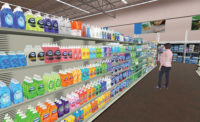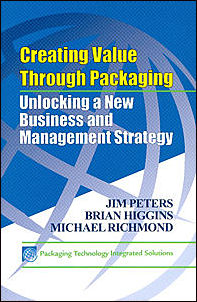Avoid Mistakes, Maximize Equity In Converting To a Shrink Label
![]()
Avoid Mistakes, Maximize Equity In Converting To a Shrink Label
Start with a design brief encompassing marketing and production, working backward from the end process. Then seek guidance from vendors.
By jim george
Innovation in shrink labels is more likely to occur when the design "pushes
the envelope" without stated constraints. Such an approach produces a new look in motor oil packaging.
the envelope" without stated constraints. Such an approach produces a new look in motor oil packaging.
In the battle for shelf impact, shrink-sleeve labels are becoming a prevalent packaging material in a wider number of categories. Two reasons why: shrink labels get products noticed and they help products sell.
The gloss, brilliant colors and razor-sharp graphics that adorn flexible packaging make shrink labels a desirable decorative option on glass, plastic and metal containers.
One projection, from Packaging Strategies, puts shrink label growth at 20 percent annually through at least 2005 as one solution to the challenge for attaining greater shelf impact. Besides the decorative pluses of flexible film, two additional factors are fueling the growth of shrink labels:
Marketers' desire to use the entire package as a billboard, making it a sales tool from all four sides as mass merchandisers and club stores gravitate toward pallet displays ready for immediate sale on the store floor.
They can pull double duty as a tamper-evidence tactic.
But while they hold the promise of dazzling, colorful "canvases," shrink labels can spell disaster for brand managers who fail to investigate the nuances and consult and coordinate the necessary team members from the earliest stages.
BRANDPACKAGING magazine asked a package designer, film supplier, prepress vendor, ink supplier and a converter what it takes to create a successful shrink label. Here are their perspectives.
First, plan the design
The first step in creating a successful shrink label is planning the design. You want a label that mirrors what you created on your computer screen.
Tackle the challenge from two perspectives—marketing and production, says Dennis Furniss, Director of Strategic Branding at BrandScope, a Chicago branding and design consultancy. Strive for visual pizzazz but understand that you probably won't achieve it if your design fails to consider the entire value chain.
Bring all functions of your team on board as you create your label. A shrink label faces its own particular challenges, and a cross-section of expertise can explain what works and what doesn't before you begin spending time and money developing a sleeve that's destined to send you back to the drawing board.
For example, one design issue brand managers often underestimate is the film's impact on graphics.
A shrink label usually doesn't adorn an entirely flat package surface. It is heat- or steam-shrunk as much as 80 percent to hug the package surface where it abruptly changes shape.
As the film shrinks over these "peaks and valleys," text and graphics change in appearance both vertically and horizontally. A converter can offer advice on modifying the graphics—the term is called "distortion"—so they will match the design on your computer screen.
You may find that critical graphic elements fall into areas requiring high shrink. Now is the time to consider moving these elements to another part of the label. You want to avoid risking an inconsistent look on core graphics and marks that hold the equity in your brand.
Consider these additional issues during the design phase:
- Text may need to be moved around the label due to the container shape. Graphics may need to be altered to allow the printer to properly register the image. Your prepress vendor and your printer can help determine optimum placement.
- Different films have different shrink properties. Brand managers should understand these variations.
Two additional tools can steer your planning. First, a strong design brief provides the framework for identifying and addressing both marketing and production issues.
Second, a physical mockup or a virtual mockup gives you an opportunity to review the design as it will look on the store shelf.
Furniss recommends streamlined planning that begins with production and works backward. This ensures that your design works in operations and sequences procedures in the design brief.
Consider film options
The film you select dictates a great deal of what you can do with your label. Polyvinyl chloride (PVC) is the most widely used shrink film.
Where to go for more information... |
| * Branding and design services. At BrandScope, contact Tracy Kiker at 773.533.2191 or tracykiker@brandscope.com * Shrink labels. At Alcoa Flexible Packaging, contact Terry Copenhaver at 804.281.2395 or terry.copenhaver@alcoa.com * Prepress services. At Esko-Graphics, contact Mark Vanover at 413.583.4100, ext. 140 or mrva@esko-graphics.com * Ink technology. At Coates Inks, contact Brendan Maunsell at 864.288.4931or brendan.maunsell@coatesinks.com * Shrink labels and converter services. At Fort Dearborn, contact Tim Nicholson at 847.357.9500 or tnicholson@fortdearborn.com |
It's comparatively inexpensive and has a shrink range of 20 percent to 65 percent. This satisfies the requirements posed by many contoured containers.
Consider oriented polypropylene (OPP) if your label requires shrinkage of less than 20 percent on a more basic cylindrical shape.
Specialty co-polyesters are more frequently becoming the film of choice in decorating highly complex package shapes. Some in the packaging industry refer to these very high-shrinkage films as PETG, and they work well on labels requiring shrinkage exceeding 70 percent.
Films whose shrink capability doesn't meet the requirements of a specific package can result in problems such as "muddy" graphics and damaged labels or containers during the shrinking process. And labels may not fully conform to the container shape.
Film choice affects the distortion requirements for graphics, explains Terry Copenhaver, Commercial Manager, Alcoa Flexible Packaging.
Copenhaver recommends that brand managers align with a full-service supplier that understands the impact of artwork and film, and printing's impact on it.
Don't forget prepress
Marketing sometimes spends so much time focusing on the label design meeting branding goals that it gives short shrift to the impact downstream. Prepress is one area that gets overlooked.
Bringing in a prepress vendor to collaborate with design and production at the earliest stages of label creation can save you time, avoid waste and get your product to shelf faster, says Mark Vanover, Director of Marketing at Esko-Graphics, a Kennesaw, Ga., supplier of packaging prepress workflow and digital imaging services.
Significant time (and money) savings are possible when prepress helps you spearhead a collaborative workflow. More often, the workflow is becoming digitized.
"Presenting the packaging concept, defining the container shape and the shrink material as well as the shrinkage technique are all important for a successful project," Vanover says.
Vanover suggests asking these questions during the qualification interview for prepress vendors:
1. How will distortion affect design during shrinking?
2. Do you have a Web-based collaborative project management system that enables the supply chain to communicate on a project?
3. Can you show a digital 3-D rendering of the container with my shrink label applied?
Understanding inks
When you meet with your printer, consider a joint consultation with technical representatives from ink suppliers well-versed in shrink labels. This point comes from Brendan Maunsell, Vice President at Coates Inks, a member of the Sun Chemical Group, in Greer, S.C.
Ink selection should take into account the container material, bottle-blocking resistance, the film, scuff resistance, and the level of opacity you require in the white layer(s) or the desired level of transparency in colors.
Adjustments in ink properties can answer challenges posed when the product contains oils or other components that could migrate through the container.
An ink supplier can also help select inks that work in harmony with the film to achieve the dazzling special effects that intensify shelf impact, Maunsell says. You can learn about light- and temperature-activated inks.
The final frontier—printing
Most shrink labels exhibit either rotogravure or flexographic printing. Understand the possibilities when using both of these printing processes before qualifying a printer; not all converters print in both methods.
Among the assistance a converter can give you:
- Advice on distortion rates so you avoid losing the fine detail work.
- Recommendations for optimum graphics placement.
- Assistance in running a "grid pattern"—a test of horizontal and vertical lines for assessing the required level of graphic distortion—after your print has been sleeved and shrunk via a hot-air or steam tunnel onto the container.
Tim Nicholson, Senior Director of Business Development at Fort Dearborn Co., Niles, Ill., offers this thought:
"Shrink sleeves are 'active' labels in that the final appearance of the labeled container will be different than what the label looked like as it entered your plant, because it is designed to conform to your container." BP
The author, Jim George, is the Senior Editor
of BRANDPACKAGING magazine.
Looking for a reprint of this article?
From high-res PDFs to custom plaques, order your copy today!






